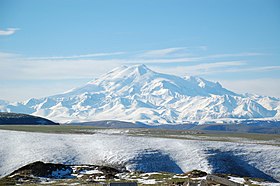Einsame Maria
| Einsame Maria | |
|---|---|
| Txol'ulk'Alara | |
 The Einsame Maria in the summer; the mountain is permanently snowcapped. | |
| Highest point | |
| Peak | the Virgin's Throne (der Jungfrauthron) |
| Elevation | 5,734 m (18,812 ft) |
| Listing | Kupferberg Country high point |
| Naming | |
| Etymology | Named after the Virgin Mary, einsame ("lone") referring to the peak's prominence. Known in Nünsyi as Txol'ulk'Alara, 'the mountain where Alara dwells' |
| Geography | |
| Country | |
| Province | Kupferberg |
| Parent range | Kupferberg Mountains |
| Geology | |
| Mountain type | Stratovolcano |
| Type of rock | Metamorphic and igneous rock, principally gneiss and rhyolite |
| Last eruption | 275 BC ± 10 years |
| Climbing | |
| First ascent | 23 May 1882 (official), 275 BC (legendary) |
| Access | Ministerial permit required, <10 granted per year |
The Einsame Maria (the Lone Maria), also known in Nünsyi as Txol'ulk'Alara (the mountain[1] where Alara dwells) is the largest mountain in Hendalarsk and one of the largest mountains in Levantia. A dormant stratovolcano whose last significant eruption occurred around 2300 years ago, the Einsame Maria is an iconic symbol of Hendalarsk both domestically and internationally and is revered in various cultural and religious traditions across the nation.
Culture
The Einsame Maria is one of the most important religious sites in Hendalarsk. Revered for millennia due to its enormous size and isolation, it is of great spiritual significance in both Hendalarskara Catholicism and Nünsyi belief, although it is abhorred by the Khunyer in line with their wider distrust of mountains in general and volcanoes in particular.
Alara
Traditional Nünsyi folklore holds that the mountain is the resting-place of Alara, the Nünsyi culture hero responsible for, among other things, the discovery of metallurgy. After he was betrayed and defeated in a climactic battle by his brother-in-law Gelhuk, Alara crawled southwards from the sea for almost a thousand miles, with the blood from a wound in his side forming the route of the river Herne (Nünsyi: TBC) and its longest left-bank tributary, the Holwen. On reaching the mountain, Alara is said to have climbed into its caldera and hurled himself into its depths - rather than dying, however, he was carried safely into a chamber in the volcano's depths, where he has slumbered ever since. The volcano's resident spirit[2], on learning from Alara of how he had come to the volcano, was so enraged at Gelhuk's treachery that it erupted, vowing to destroy Gelhuk's kingdom. The resulting eruption devastated much of the Herne watershed, and Nünsyi legend has it that Gelhuk was sacrificed by his own people in an effort to appease the gods and atone for their desertion of Alara.
Hendalarskara Catholicism
Notes
- ↑ There is no distinction in Nünsyi between 'mountain' and 'volcano'.
- ↑ in Nünsyi culture, it is taboo to name spirits; instead the name of a geographical feature is prefaced with Gal', 'spirit of', meaning that the name of the Einsame Maria's spirit-being is Gal'Txol'ulk'Alara, 'the spirit of the mountain where Alara dwells'